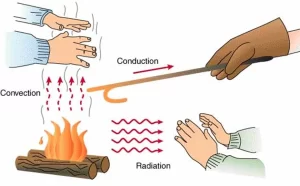Solar energy (Sun), Ways of heat transfer (conduction, convection and radiation)
Mechanical energy is changed into heat energy, The temperature of objects increases by increasing their speed due to the increase of their kinetic energy, You feel warm when you rub your hands together in winter because the kinetic energy is converted into heat energy by friction, When you shake metallic spheres in a closed tube, their temperature increases because by friction.
How can we get heat energy?
We can get heat energy by many ways such as the Sun & changing the mechanical (kinetic) energy into heat energy by friction, Burning a match stick when it contacts a rough surface due to the conversion of the mechanical energy into heat energy by friction, The nail gets hot when you pull it out from a thick wooden piece because the friction between the nail & the wooden piece generates heat energy which causes the hotness of the nail.
When you invert your bicycle, Let the pedal turns fast, then press the bicycle brakes strongly, and touch the frame of the wheel after it stops, you will feel that the tire and brakes become hot due to friction between them because mechanical energy is converted into heat energy.
When you put spheres in a plastic jar & record their temperature by using a thermometer, the temperature of the spheres increases gradually after shaking, Increasing the speed of spheres and their friction with each other during shaking leads to increasing their kinetic energy and therefore their temperature rises.
Kinetic energy changes into heat energy, because sphere movement and their friction with each other raise the temperature, the temperature is directly proportional to the speed of objects and therefore to their kinetic energy.
How is heat energy transferred?
Heat is transferred from an object with a higher temperature to another of lower temperature, then it stops when they are equal in temperature, Heat is a form of energy that is transferred from an object with a higher temperature to that with a lower temperature, Temperature is the heat condition that determines the direction of heat energy whether from or to the object when it comes in contact with another.
Ways of heat transfer
- The transfer of heat by conduction through some solid objects.
- The transfer of heat by convection through gases and liquids.
- The transfer of heat by radiation through material media and non-material ones (space).
The transfer of heat by conduction
Heat transfers by conduction through some solid objects (metallic spoon) from one side to the other, Cooking pans are made up of copper & aluminium because they are good conductors of heat, When you put a metallic spoon in a cup of hot tea for a time, you feel the hotness of the spoon because heat is transferred through solids by conduction.
Transfer of heat by conduction is the transfer of heat through some solid objects from the part with a higher temperature to that with lower temperature, You feel hot when you touch a hot metallic spoon because heat is transferred from the hot object (spoon) to the cold object by conduction
The transfer of heat by convection
Transfer of heat by convection is the transfer of heat in gases & liquids, where hot molecules which have less density rise upwards, while colder molecules which have more density fall down, The freezer of the fridge is found at the top of the fridge because when air is cooled, its density increases, so, it falls down to cool the food in the refrigerator, while the hot air (with low density) rises up to be cooled again and so on.
The electric heater is placed at the bottom of the room because when air (around the heater) is heated, its density decreases, so, it rises up to warm the room, while the cold air (with high density) falls down to be heated again and so on, The air conditioner is fixed at the upper part of the room to cool the air in the upper part of the room, where its density increases, so, it falls down, while the hot air rises up to be cooled and so on.
The transfer of heat by radiation
The heat of the Sun is transferred to the Earth without any need for a material medium and this way is known as the transfer of heat by radiation, heat is transferred by radiation through material media & non-material ones, The heat is transferred from the heater to our bodies by convection & radiation.
The transfer of heat by radiation is the transfer of heat from a hot object to another without any need for a material medium through which heat transfers, Heat is transferred from all resources of light by convection and radiation, while heat is transferred from the Sun by radiation only.
The heat of the Sun is transferred to us by radiation because there is a space (vacuum) between the sun and the Earth and the transfer of heat by radiation doesn’t need any material medium through which heat transfers.
Wearing dark clothes in winter to absorb the heat of the Sun, Wearing light colours clothes in summer to reflect the sun rays, The heat of the Sun doesn’t reach the Earth by conduction or convection, It is not transferred by conduction because the air is a bad conductor of heat and it is not transferred by convection because there is a space (vacuum) between the Sun & the Earth.
Technological applications that produce heat
There are a lot of technological applications that produce heat, but they are different in:
- The energy resources that they depend on.
- The kind of energy resources.
- The effect on the environment.
Some examples of technological applications that produce heat energy
Electric heaters, Electric water heaters and electric stoves depend on electricity which is a renewable resource of energy & non-polluting to the environment, Solar heaters and Solar ovens depend on the Sun which is a permanent resource of energy & non-polluting to the environment.
Gas or petrol stove depends on petroleum derivatives which are non-renewable energy resources & polluting to the environment, Gas oven depends on natural gas (Butan gas) which is a non-renewable resource of energy & polluting to the environment.
Coal fire depends on coal which is a non-renewable resource of energy and pollutes the environment, In solar cells and solar batteries, Solar energy changes into electric energy, In solar heaters, solar ovens and solar furnaces, Solar energy changes into heat energy.
Solar energy (the Sun) is the origin of most energies
Solar energy is considered the cleanest and cheapest source of energy because it doesn’t pollute the environment, It changes into other energies such as chemical energy is stored in petroleum oil & coal, Chemical energy is stored in plants by the photosynthesis process, Heat energy as in solar furnace (oven) and solar heater, Electric energy as in solar cells or solar batteries which is changed into:
- Light & heat energies as in the electric lamp.
- Kinetic energy as in the electric fan.
- Heat energy as in the electric heater.
Solar energy is the cause of the wind movement which has kinetic energy that in turn is used to generate electric energy, the importance of solar energy in our life is because the Sun is the main source of most energies on the Earth’s surface.
The production of electricity from solar energy is preferred to that which is produced from burning of fuel as solar energy is a permanent source of energy, the Sun is a clean source of energy that doesn’t pollute the environment,
It is preferred to use the Sun and electricity as sources of heat energy than coal and petrol because the Sun and electricity don’t pollute the environment, while coal and petrol pollute the environment.
The importance and uses of solar cells (photovoltaic cells)




